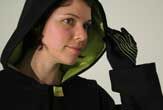‘Smart’ Clothing Responds to Wearer’s Emotions

High-tech clothing with embedded biosensors and an Internet connection could respond to your mood and help you get through the day.
The new “smart” clothing contains wireless biosensors that measure heart rate and temperature (among other physiological indicators), small speakers, and other electronics that wirelessly connect to a handheld smartphone or PDA. Data from the sensors is sent to the handheld where it is converted into one of 16 emotional states, which cues a previously setup database to send the wearer some inspirational message.
These "mood memos" could be a text message, which scrolls on a display on the garment’s sleeve, a video or photograph displayed on the handheld device, or a sound that comes through the embedded speakers.
The researchers have made two prototype garments so far, a male and a female version, and plan to display them at museums over the next two years. They are also looking at medical and fashion applications.
The sounds, photos and videos sent to the wearer aren’t arbitrary. Instead, the messages are spoken by a friend or loved one.
“When you first wear the garment, you turn on the device and you tell it what person you want to channel that day,” said Barbara Layne, professor at Concordia University and co-developer of the garments. “That could be your lover who’s away, it could be your deceased parent, your best friend, whoever you want to be with that day.”
The multimedia is pre-loaded into a database for each person the wearer wants to virtually hang out with.
Sign up for the Live Science daily newsletter now
Get the world’s most fascinating discoveries delivered straight to your inbox.
“[At] multiple times during the day, you can set it for as many times as you want, [the garment] will take your biometric readings, your bio-sensing data, analyze it on that emotional map and then go up to the Internet, to the database that relates that emotional state, and bring you back something that you need,” Layne said.
Layne and co-developer Janis Jefferies, professor at the University of London’s Goldsmiths, along with their team members have not yet pursued commercial applications but are seeing a lot of interest.
“The interest is really huge from all kinds of sectors,” Layne said. One example is the medical area, which could use the smart clothing “to promote well-being maybe for someone who’s ill, either house-bound or in a hospital where wearing this kind of jacket can make them feel better,” Layne said.
In the future, the researchers hope to work with a behavioral psychologist to improve the model used to convert the physical data – heart rate and temperature, for example – into an emotional state.












